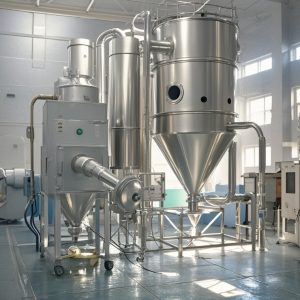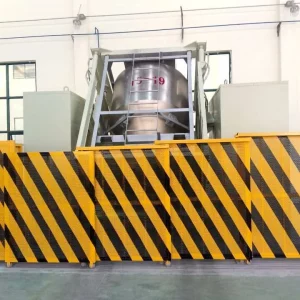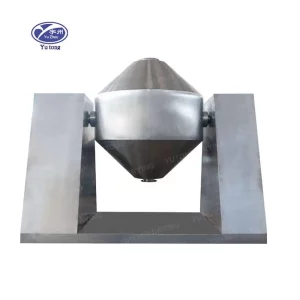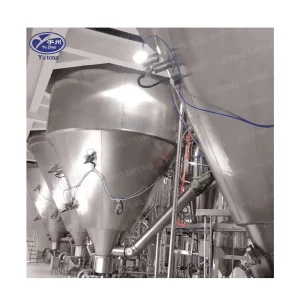fluidized bed dryer market
The fluidized bed dryer market is gaining significant traction in industrial drying solutions. This advanced drying technology offers numerous benefits over traditional drying methods, making it an attractive choice for various industries, including pharmaceuticals, food processing, and chemicals. In this article, we will explore the fluidized bed dryer market, its applications, and why it is becoming an essential component in industrial drying solutions.
What is a Fluidized Bed Dryer?
A fluidized bed dryer is a type of industrial drying equipment used to reduce the moisture content of particulate materials. The drying process involves suspending solid particles in a stream of air or gas, creating a fluidized state. This fluidization allows for efficient heat and mass transfer, resulting in uniform drying of the materials.
Key Components of a Fluidized Bed Dryer
A fluidized bed dryer comprises several essential components that work together to achieve efficient drying. The main element is the drying chamber, where the actual fluidization occurs. This chamber is equipped with a perforated plate that allows the passage of air or gas. Additional components include the air handling unit, which provides the necessary airflow, and the exhaust system, which removes moisture-laden air from the chamber. These components are designed to facilitate optimal heat and mass transfer.
Principles of Fluidization
The core principle behind fluidized bed drying is fluidization. Fluidization occurs when a fluid (usually air or gas) passes through a bed of solid particles at a velocity sufficient to suspend the particles, creating a fluid-like state. This state enhances the contact between the drying medium and the particles, promoting rapid heat and moisture transfer. The fluid-like behavior of the particles ensures uniform drying, as each particle is exposed to the drying medium.
Variants of Fluidized Bed Dryers
Fluidized bed dryers come in various configurations, each designed to meet specific industrial needs. Batch fluidized bed dryers are used for processing small quantities, providing flexibility and control over drying conditions. Continuous fluidized bed dryers, on the other hand, are designed for large-scale operations, offering high throughput and efficiency. Additionally, there are specialized variants like vibrated fluidized bed dryers, which incorporate mechanical vibration to enhance the fluidization and drying of cohesive or sticky materials.
How Does a Fluidized Bed Dryer Work?
In a fluidized bed dryer, a stream of air or gas is passed through a perforated plate or a bed of solid particles. As the air velocity increases, the particles are lifted and suspended, creating a fluid-like state. This fluidization enhances the contact between the drying medium and the particles, facilitating rapid heat and moisture transfer. The dried particles are then separated from the air stream and collected for further processing.
The Fluidization Process
The process of fluidization begins with the introduction of air or gas at the base of the drying chamber. As the airflow increases, it lifts the particles, suspending them in the air. This creates a dynamic interaction between the particles and the air, allowing for efficient heat transfer. The fluidized state is maintained by controlling the airflow rate, ensuring that the particles remain suspended and uniformly dried.
Heat and Mass Transfer Dynamics
The efficiency of a fluidized bed dryer lies in its ability to promote adequate heat and mass transfer. As the particles are suspended in the air, they experience a high degree of mixing, which enhances heat transfer. The continuous movement of particles ensures that each particle is exposed to the drying medium, resulting in uniform drying. The mass transfer process involves the removal of moisture from the particles, which is carried away by the airflow.
Particle Separation and Collection
Once the drying process is complete, the dried particles need to be separated from the air stream. This is achieved using cyclones or bag filters, which capture the dried particles while allowing the air to escape. The collected particles are then ready for further processing or packaging. Efficient particle separation is crucial to prevent product loss and ensure the quality of the dried material.
Advantages of Fluidized Bed Dryers
Fluidized bed dryers offer several advantages over traditional drying methods, making them a popular choice in various industries:
Efficiency and Uniformity
One of the primary advantages of fluidized bed dryers is their efficiency. The fluidized state ensures uniform drying as each particle is exposed to the drying medium. This results in consistent product quality and reduces the risk of over-drying or uneven drying. The efficient heat transfer also reduces drying time, leading to increased productivity and lower energy consumption.
Scalability and Flexibility
Fluidized bed dryers are highly scalable, making them suitable for both small-scale and large-scale industrial applications. They can be configured to meet specific production requirements, offering flexibility in terms of batch size and drying conditions. This scalability makes them ideal for industries with varying production demands, allowing for seamless integration into existing production lines.
Versatility and Material Handling
These dryers can handle a wide range of materials, including powders, granules, and pellets. Their versatility makes them suitable for diverse industries, from pharmaceuticals to food processing. The ability to process different materials without significant modifications to the equipment is a key advantage, providing manufacturers with the flexibility to adapt to changing market demands.
Precise Control and Customization
Fluidized bed dryers offer precise control over drying parameters, such as temperature, airflow, and residence time. This level of control allows manufacturers to customize the drying process based on specific material requirements, ensuring optimal drying conditions. The ability to fine-tune drying parameters enhances product quality and consistency, meeting stringent industry standards.
Applications of Fluidized Bed Dryers
The fluidized bed dryer is used across several industries due to its efficiency and versatility. Here are some of its key applications:
Pharmaceutical Industry
In the pharmaceutical sector, fluidized bed dryers are widely used for drying granular and powdered materials. This technology ensures that active pharmaceutical ingredients (APIs) and excipients are uniformly dried, maintaining their quality and stability. Moreover, fluidized bed dryers are essential in processes like granulation and coating, ensuring consistent results.
Drying Active Pharmaceutical Ingredients
Fluidized bed dryers play a crucial role in drying active pharmaceutical ingredients (APIs). Their uniform drying capability ensures that APIs retain their potency and efficacy, which is vital for producing effective pharmaceutical products. The precise control over drying parameters helps maintain the integrity of temperature-sensitive APIs, preventing degradation during the drying process.
Enhancing Granulation and Coating Processes
In pharmaceutical manufacturing, granulation and coating are critical processes that require uniform and controlled drying. Fluidized bed dryers provide the necessary environment for achieving consistent granulation, ensuring that the final product meets the desired specifications. Additionally, these dryers are used for film-coating tablets, where even drying is essential for achieving uniform coating thickness and adhesion.
Compliance with Regulatory Standards
Pharmaceutical manufacturing is governed by strict regulatory standards that demand high-quality and safe products. Fluidized bed dryers help manufacturers comply with these regulations by ensuring consistent and controlled drying processes. The ability to customize drying parameters and maintain uniform drying conditions contributes to the production of pharmaceutical products that meet industry standards.
Food Processing Industry
Fluidized bed dryers play a critical role in the food processing industry by drying various food products such as grains, cereals, and spices. The uniform drying provided by these dryers helps preserve the nutritional value and flavor of the food. Additionally, fluidized bed dryers are used in the production of instant foods, where rapid and even drying is essential.
Preserving Nutritional Value and Flavor
The food processing industry relies on fluidized bed dryers to preserve the nutritional content and flavor of food products. The uniform drying process prevents nutrient loss and helps retain the natural flavors of grains, cereals, and spices. This is particularly important for products where taste and nutritional value are key selling points, ensuring that consumers receive high-quality food items.
Production of Instant Foods
Instant foods require rapid and uniform drying to achieve the desired texture and rehydration properties. Fluidized bed dryers are ideal for this purpose, as they provide consistent drying conditions that result in uniform moisture content across the product. This ensures that instant foods rehydrate quickly and evenly, meeting consumer expectations for convenience and quality.
Drying Specialty and Value-Added Products
Fluidized bed dryers are also used for drying specialty and value-added food products, such as herbal teas, dehydrated fruits, and vegetable powders. These products require precise control over drying parameters to preserve their unique characteristics and enhance shelf life. The versatility of fluidized bed dryers allows manufacturers to tailor the drying process for a wide range of food products, expanding their product offerings.
Chemical Industry
In the chemical industry, fluidized bed dryers dry a wide range of chemicals and intermediates. This technology is vital for processes such as the production of polymers, resins, and detergents, where precise control over drying parameters is crucial to achieving desired product characteristics.
Drying of Polymers and Resins
Fluidized bed dryers are extensively used in the production of polymers and resins, where controlled drying is essential for achieving the desired physical and chemical properties. Maintaining consistent drying conditions helps prevent defects and ensures uniform quality in the final product, which is critical for applications where polymers and resins are used in high-performance products.
Drying Intermediates and Specialty Chemicals
The chemical industry often deals with intermediates and specialty chemicals that require precise drying to ensure stability and reactivity. Fluidized bed dryers provide the necessary control over drying conditions, allowing manufacturers to achieve the desired properties of these chemicals. This is particularly important for processes where chemical composition and purity are critical to the final product’s functionality.
Enhancing Energy Efficiency in Chemical Processes
The chemical industry is increasingly focused on improving energy efficiency and reducing operational costs. Fluidized bed dryers contribute to these goals by providing efficient heat and mass transfer, resulting in reduced energy consumption. The ability to optimize drying conditions and minimize energy usage aligns with the industry’s sustainability initiatives, helping manufacturers achieve their environmental targets.
Market Trends and Growth Drivers
The fluidized bed dryer market is experiencing significant growth, driven by several key factors:
Increasing Demand for Efficient Drying Solutions
As industries continue to seek efficient and cost-effective drying solutions, the demand for fluidized bed dryers is rising. These dryers offer energy-saving benefits and improved product quality, making them an attractive choice for manufacturers looking to optimize their processes.
Industry Shift Towards Sustainable Practices
The global push towards sustainability is influencing the adoption of energy-efficient technologies, including fluidized bed dryers. Industries are increasingly prioritizing environmentally friendly practices, and fluidized bed dryers align with these goals by offering reduced energy consumption and lower carbon emissions. This shift is driving the demand for advanced drying solutions that contribute to sustainable manufacturing practices.
Cost-effectiveness and Process Optimization
Manufacturers are constantly seeking ways to optimize production processes and reduce costs. Fluidized bed dryers offer significant cost-saving benefits through reduced energy consumption and shorter drying times. The ability to achieve uniform drying and high product quality further enhances their appeal, as manufacturers can produce consistent and reliable products while minimizing operational expenses.
Growing Awareness of Quality Standards
Industries are placing greater emphasis on quality control and adherence to industry standards. Fluidized bed dryers provide the precise control needed to meet stringent quality requirements, ensuring that products consistently meet customer expectations. This focus on quality is driving the adoption of fluidized bed dryers across various sectors as manufacturers seek reliable solutions that enhance product quality.
Technological Advancements
Advancements in fluidized bed dryer technology, such as improved control systems and automation, are enhancing their efficiency and performance. These innovations are driving the adoption of fluidized bed dryers across various industries, further fueling market growth.
Integration of Automation and IoT
The integration of automation and IoT (Internet of Things) technologies in fluidized bed dryers is transforming their operational capabilities. Automated control systems allow for real-time monitoring and adjustment of drying parameters, improving efficiency and reducing the need for manual intervention. IoT connectivity enables remote monitoring and predictive maintenance, minimizing downtime and optimizing performance.
Development of Advanced Control Systems
Recent developments in control systems have enhanced the precision and flexibility of fluidized bed dryers. Advanced control algorithms enable manufacturers to fine-tune drying conditions based on specific material properties, ensuring optimal drying performance. These systems also provide data analytics capabilities, allowing manufacturers to gain insights into their processes and identify areas for improvement.
Innovations in Dryer Design and Materials
Innovations in dryer design and materials are contributing to the improved performance of fluidized bed dryers. New materials and coatings are being developed to enhance durability and resistance to wear and corrosion, extending the equipment’s lifespan. Additionally, innovative designs are being introduced to improve airflow distribution and heat transfer efficiency, further enhancing the drying process.
Expanding Applications in Emerging Markets
Emerging economies are witnessing rapid industrialization, leading to increased demand for efficient drying solutions. The fluidized bed dryer market is expanding in these regions, driven by the growth of industries such as pharmaceuticals, food processing, and chemicals.
Industrialization and Economic Development
Emerging markets are experiencing rapid industrialization, driven by economic development and investment in manufacturing sectors. As industries expand, the demand for advanced drying technologies like fluidized bed dryers is increasing. These markets offer significant growth opportunities for manufacturers as they seek to meet the rising demand for efficient and reliable drying solutions.
Growth of Local Manufacturing Capabilities
The growth of local manufacturing capabilities in emerging markets is contributing to the demand for fluidized bed dryers. As local manufacturers aim to improve product quality and competitiveness, they are investing in advanced technologies that enhance production processes. Fluidized bed dryers provide the necessary efficiency and control to support the development of high-quality products in these regions.
Government Initiatives and Infrastructure Development
Government initiatives and infrastructure development in emerging markets are creating a conducive environment for industrial growth. Policies that promote investment in manufacturing and technology adoption are driving the demand for fluidized bed dryers. Additionally, infrastructure improvements are facilitating the establishment of new manufacturing facilities, further supporting market expansion.
Challenges in the Fluidized Bed Dryer Market
While the fluidized bed dryer market is growing, it faces particular challenges that need to be addressed:
High Initial Investment
The initial cost of purchasing and installing fluidized bed dryers can be significant, particularly for small and medium-sized enterprises. This high initial investment may deter some companies from adopting this technology.
Cost Barriers for Small Enterprises
The high initial investment required for fluidized bed dryers can be a significant barrier for small and medium-sized enterprises (SMEs). These enterprises often operate with limited budgets and may find it challenging to allocate resources for such capital-intensive equipment. Addressing these cost barriers is crucial to enabling broader adoption and accessibility of fluidized bed dryers across different business scales.
Financing and Leasing Options
To overcome the challenge of high initial investment, manufacturers and suppliers are exploring financing and leasing options. These options provide businesses with flexible payment plans, allowing them to spread the cost of acquiring fluidized bed dryers over time. By offering financial solutions, manufacturers can make their equipment more accessible to a broader range of industries and companies.
Return on Investment Considerations
While the initial cost may be high, businesses should consider the long-term return on investment (ROI) offered by fluidized bed dryers. The efficiency, energy savings, and improved product quality provided by these dryers can lead to significant cost reductions over time. Highlighting the long-term benefits and ROI can help justify the initial investment and encourage adoption.
Maintenance and Operational Costs
Fluidized bed dryers require regular maintenance to ensure optimal performance. The operational costs associated with energy consumption and maintenance can be a concern for some manufacturers.
Importance of Regular Maintenance
Regular maintenance is essential to ensure the efficient operation of fluidized bed dryers. Proper maintenance practices help prevent equipment breakdowns, reduce downtime, and extend the equipment’s lifespan. Manufacturers must establish comprehensive maintenance schedules and protocols to address potential issues and maintain optimal performance.
Energy Consumption and Cost Management
Energy consumption is a significant operational cost for fluidized bed dryers. Manufacturers need to implement strategies to optimize energy usage and reduce costs. This can include investing in energy-efficient technologies, optimizing drying parameters, and implementing energy management systems. By managing energy consumption effectively, manufacturers can minimize operational costs and improve overall profitability.
Training and Skilled Workforce
The operation and maintenance of fluidized bed dryers require skilled personnel with specialized knowledge. Manufacturers need to invest in training programs to ensure their workforce is equipped with the necessary skills to operate and maintain the equipment. By building a skilled workforce, manufacturers can enhance operational efficiency and minimize the risk of equipment failures.
Competition from Alternative Drying Technologies
The fluidized bed dryer market faces competition from alternative drying technologies such as spray dryers and rotary dryers. To remain competitive, manufacturers must continually innovate and improve their products.
Diverse Drying Technology Landscape
The drying technology landscape is diverse, with various options available to manufacturers. Each technology offers unique advantages and is suitable for specific applications. Fluidized bed dryers compete with alternatives such as spray dryers, rotary dryers, and vacuum dryers. Manufacturers need to differentiate their products by highlighting the specific benefits and capabilities of fluidized bed dryers.
Innovation and Product Differentiation
To remain competitive, manufacturers of fluidized bed dryers must focus on innovation and product differentiation. This includes developing new features, improving efficiency, and enhancing performance. By offering unique solutions that address specific industry needs, manufacturers can attract customers and maintain a competitive edge in the market.
Customer Education and Awareness
Educating customers about the benefits and applications of fluidized bed dryers is crucial to overcoming competition from alternative technologies. Manufacturers should engage in customer education initiatives, providing detailed information about the advantages of fluidized bed dryers and how they can improve drying processes. By raising awareness, manufacturers can drive adoption and increase market share.
Conclusion
The fluidized bed dryer market is poised for growth, driven by the increasing demand for efficient and versatile industrial drying solutions. With advancements in technology and expanding applications across various industries, fluidized bed dryers are becoming an essential component in modern manufacturing processes.




